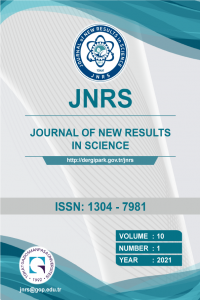Investigation of 3D Printing Occupancy Rates Effect on Mechanical Properties and Surface Roughness of PET-G Material Products
3D Printer PET-G, Printing Occupancy Rate, FDM,
___
- Ahrabi A.Z., 2009. Pet Atıkları Kullanılarak Kompozit Malzeme Üretiminin Araştırılması, Ankara Üniversitesi Fen Bilimleri Enstitüsü Yüksek Lisans Tezi, Kimya Mühendisliği anabilim Dalı, Ankara. Bernard, Fischer, A., 2012. New Trends in Rapid Product Development, Industrial Engineering Research. Billiet, T., Vandenhaute, M., Schelfhout, J., Vlierberghe, S. V., Dubruel, P., 2012. A Review of Trends And Limitations In Hydrogel Rapid Prototyping For Tissue Engineering, Biomaterials 33, 6020-6041. Birtchnell, T., Urry, J., 2013. 3D, SF And The Future, Futures 50, 25-34. Calvert, P., 1998. Free Forming of Polymers, Polymers, 585-588 Campbell, I., Bourell, D. and Gibson, I., 2012. Additive Manufacturing: Rapid Prototyping Comes Of Age, Rapid Prototyping Journal,18 (4): 255-258. Campbell, I., Bourell, D., Gibson, I., 2012. Additive Manufacturing: Rapid Prototyping Comes of Age, Rapid Prototyping Journal, 255-258. Çelik, D., 2015. Tersine Mühendislikle Üç Boyutlu Yazıcı Tasarımı ve Üretimi Yüksek Lisans Tezi, Karabük Üni., Fen Bil. Enstitüsü. Chimento, J., Jason, M., Nathan Crane, H., 2011. 3D Printed Tooling for Thermoforming of Medical Devices, Rapid Prototyping Journal, 387 –392. Dale Prince, 2014. 3D Printing: An Industrial Revolution, Journal of Electronic Resources in Medical Libraries, 39-45. Fantini, M., Crescenzio, F. D., Persiani, F., Benazzi, S., Gruppioni, G., 2008. 3D Restitution, Restoration And Prototyping of A Medieval Damaged Skull, Rapid Prototyping Journal,318 –324. Günther D., Heymel B., Günther F. J. and Ederer I., 2014. Continuous 3D Printing for Additive Manufacturing, Rapid Prototyping Journal, 20 (4): 320327. Kashdan, L., Seepersad, C. C., Haberman, M., Wilson, P. S., 2012. Design, Fabrication, And Evaluation of Negative Stiffness Elements Using SLS, Rapid Prototyping Journal,194-200. Kroll, E. and Artzi, D., 2011. Enhancing Aerospace Engineering Students Learning With 3D Printing Wind-Tunnel Models, Rapid Prototyping Journal,17 (5): 393 -402. Lee, C.S., Kim, S.G., Kim, H.J., Ahn, S.H., 2007. Measurement of Anisotropic Compressive Strength of Rapid Prototyping Parts, Journal of Materials Processing Technology, 627–630. Levy, G. N., Schindel, R. and Kruth, J. P., 1996. Rapid Manufacturing And Rapid Tooling With Layer Manufacturıng (Lm) Technologies, State of The Art And Future Perspectives, 1 (1): 1-21. Marchelli, G., Prabhakar, R., Storti, D., Ganter, M., 2011. The Guide to Glass 3D Printing: Developments, Methods, Diagnostics And Results, Rapid Prototyping Journal, 187-194. Palousek, D., Rosicky, J., Koutny, D., 2014. Pilot Study of The Wristorthosis Design Process, Rapid Prototyping Journal, 27-32. Paulic, M., Irgolic, T., Balic, J., Cus, F., Cupar, A., Brajlih, T., Drstvensek, I., 2014. Reverse Engineering of Part Swith Optical Scanning And Additive Manufacturing, Procedia Engineering, 795-803. Pham, D. T. and Gault, R. S.,1997. A Comparison of Rapid Prototyping Technologies, International Journal of Machine Tools & Manufacture, 38 (1): 1257-1287. Piattoni, J., Candini, G.P., Pezzi, G., Santoni, F., Piergentili, F., Astronautica, A., 2012. Plastic Cubes At: An Innovative And Low-Cost Way To Perform Applied Space Research And Hands-On Education, Act An Astronautica, 419-429. Polzin, C., Spath, S., Seitz, H., 2013. Characterization and Evaluation of A PMMA-Based 3D Printing Process, Department of Mechanical Engineering, 37-43. Qiu, D., Langrana, N. A., 2002. Void Eliminating Tool Path Forex Trusion Based Multi-Material Layered Manufacturing, Rapid Prototyping Journal, 38–45. Ruffo, M., Tuck, C., Hague, R., 2007. Make or Buy Analysis for Rapid Manufacturing, Rapid Prototyping Journal, 23-29. Singare, S., Lian, Q., Ping Wang, W., Wang, J., Liu, Y., Li, D., Lu, B., 2009. Stereo Lithography Model; (B And C) Custom Made Implant and Stero lithography Skull Model Used In Preoperative Planning, Rapid Prototyping Journal,19-23. Stephens, B., Azimi, P., El Orch, Z. and Ramos, T., 2013. Ultrafine Particle Emissions From Desktop 3D Printers, Atmospheric Environment, 79:334-339. Turner, B.N., Strong, R. and Gold, S. A., 2014. A Review of Melt Extrusion Additive Manufacturing Processes: I. Process Design And Modeling, Rapid Prototyping Journal, 20 3): 192-204. Vaezi, M., Chianrabutra, S., Mellor, B., Yang, S., 2013. Multiple Material Additive Manufacturing-Part 1: A Review, Virtual and Physical Prototyping, 19-50.
- ISSN: 1304-7981
- Yayın Aralığı: 3
- Başlangıç: 2012
- Yayıncı: TOKAT GAZİOSMANPAŞA ÜNİVERSİTESİ
Hakan ARSLAN, Mostafa RANJBAR, Burak DALKILIÇ, Emin ÇALIK, Cem ARSLAN
Mehpeyker Kocakoç, Recep Tapramaz
